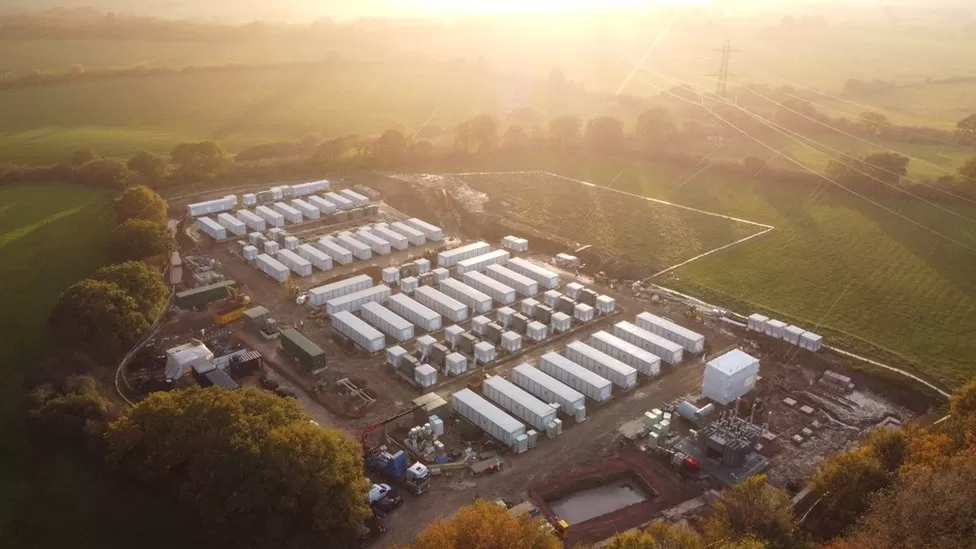
Huge battery storage plants could soon become a familiar sight across the UK, with hundreds of applications currently lodged with councils.
In one corner of West Yorkshire locals are fighting plans to site two facilities within a mile of their homes.
They cite concerns over the safety and environmental impact of the technology but the firms behind them say the processes are safe.
BBC Yorkshire spoke to those on both sides of the highly charged debate.
What are battery storage plants?
In short, battery storage plants, or battery energy storage systems (BESS), are a way to stockpile energy from renewable sources and release it when needed.
When the wind blows and the sun shines turbines and solar panels may generate more energy than needed on a particular day.
That excess electricity is then stored as chemical energy, usually inside Lithium-ion batteries, so when conditions are calm and overcast it can be sent back into the power grid.
National Grid says part of its job is to manage those fluctuations and match supply with demand, but said it can become more challenging when the target is to achieve net zero carbon production.
“Fossil-fuel fired plants have traditionally been used to manage these peaks and troughs, but battery energy storage facilities can replace a portion of these so-called peaking power generators over time,” a spokesperson said.
As more power comes from wind and solar, the need for these batteries and similar storage sites is expected to grow.
“At the moment we have a total installed capacity in the UK of about 77gW, of which only 24gW is renewable,” said Prathivadi Anand from the University of Bradford.
Dr Anand, a professor of public policy and sustainability, continued: “The more we rely on renewables, we need something to balance it, because the wind is not always blowing and the sun is not always shining.”
Where are they being built?
A government database tracking the progress of UK renewable electricity schemes over 150kW through the planning system lists 1,145 battery projects in total.
According to the online tool, 93 of these sites are currently operational.
Many of the sites being selected by energy companies are on greenfield land close to existing National Grid substations.
In Cottingham, East Yorkshire, a large BESS opened in late 2022 next to a substation set to be connected to the under construction offshore Dogger Bank Wind Farm.
The site is said to store enough electricity to power 300,000 homes for two hours and was described as the biggest of its kind in Europe when it started operating.
Its launch was brought forward four months due to national concerns about winter energy shortages.
What do people living nearby think?
In south east Leeds, villagers are fighting plans for two BESS sites less than a mile apart near Allerton Bywater.
The two proposed spots were put forward in separate planning applications by Harmony Energy and Banks Renewables.
Alison Davies, a nearby resident, told the BBC: “The villages and communities around here 100% understand the need to generate renewable energy and to investigate new technologies.
“What we’re up in arms about is the siting of these – it’s the close proximity to wildlife, the RSPB’s Fairburn Ings, there’s also housing so near.”
“If they do go up in flames it would be catastrophic, the wildlife, three nearby schools, the greenbelt, it’s just so dangerous,” said local Jane Young.
Discussing how the firm selects its sites, Frances Nicholson, of Harmony Energy, said: “If there were more brownfield sites we’d build them there if they had adequate grid connections, but there isn’t the land available – hence we look at greenfield.”
How realistic are the fire risks?
Concerns around fire safety stems from the lithium within the batteries, which can cause an explosion when it overheats.
On 15 September 2020, a fire at a BESS site in Liverpool took 59 hours to extinguish and created a “significant blast”, Merseyside Fire & Rescue Service said.
The blaze on Carnegie Road “appears to be the first significant fire of its type to occur within the UK”, according to the fire service’s significant incident report.
The initial suspected cause was deemed to be “accidental ignition caused by a lithium battery failure transitioning into thermal runaway”.
Thermal runaway occurs when too much heat is generated within a battery.
Discussing residents’ fire concerns for the West Yorkshire site, Harmony Energy has said it “uses different technology” to that used at the Liverpool plant.
Ms Nicholson, from Harmony Energy, said: “If it didn’t meet the safety thresholds we wouldn’t be able to get finance or insurance for it, they are remotely monitored 24/7 and routinely maintained to insure optimum performance.
“If there’s any sign of temperature rises the whole system shuts off.”
Dame Maria Miller, Conservative MP for Basingstoke, recently told the House of Commons the “potential fire risks” were “widely acknowledged” and said proposed locations should be subject to checks by fire services.
A US database listing fires at BESS sites found 63 examples worldwide since 2011.
Scott Donegan, a West Yorkshire Fire and Rescue Service area manager, said: “One of the concerns we do have is they are new to regulation, and as a fire service we’re not a statutory consultee.
“We do encourage providers of these types of sites to engage with us early because we want to ensure that they are well managed and have robust emergency plans in place.”
